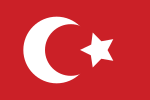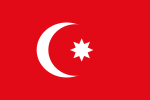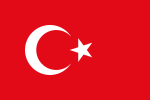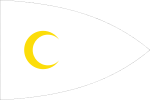Османлы байрағы: Нұсқалар арасындағы айырмашылық
Courcelles (талқылау | үлесі) ш File renamed: File:Kayihan Khanate flag.svg → File:Flag of the Kayihan Khanate (c. 1326).svg File renaming criterion #6: Harmonize file names of a set of images (so that only one part of all nam... |
Courcelles (талқылау | үлесі) |
||
| 62-жол: | 62-жол: | ||
|[[Сурет:Ottoman Civic & Merchant Flag 1793-1923.svg|thumb|151px|Османлы азамат және саудагер байрағы, 1793-1923 жж.]] |
|[[Сурет:Ottoman Civic & Merchant Flag 1793-1923.svg|thumb|151px|Османлы азамат және саудагер байрағы, 1793-1923 жж.]] |
||
|- |
|- |
||
|[[Сурет: |
|[[Сурет:Flag of the Ottoman Caliphate (1793–1844).svg|thumb|150px|Османлы діни байрағы, Халифаттың байрағы, 1793-1844 жж.]] |
||
|[[Сурет:Ottoman Army or Land Flag 1793-1923.svg|thumb|150px|Османлы әскерінің байрағы, яки құрлық күштері байрағы, 1793-1923 жж.]] |
|[[Сурет:Ottoman Army or Land Flag 1793-1923.svg|thumb|150px|Османлы әскерінің байрағы, яки құрлық күштері байрағы, 1793-1923 жж.]] |
||
|} |
|} |
||
00:48, 2013 ж. қарашаның 24 кезіндегі нұсқа
| Бұл мақаланы қазақ тіліне аудару қажет. Осы мақала туралы талқылау үшін қазақшаға аударылмаған беттер тізіміне барып шығыңыз. Егер мақаланың қазақшаға қайта жазуы екі аптада істелмесе, ол жоюға тізімделінеді және/немесе ағымдағы тіліндегі Уикипедияға жылжытылады. Егер бұл бет аударылу қажет деп белгілесеңіз, Қазақшаға аударылмаған беттер тізіміндегі осы мақала туралы бөлімнің астына мына жолды үстеңіз: {{subst:Мақала тілі | pg = Османлы байрағы | Language = белгісіз тілі | Comments = }} ~~~~. |


Османлы байрағы ұғымы Османлы әулетінің сұлтандары қолданған байрақтардың кез келгенін білдіреді. Османлы империясының тарихында түрлі байрақтар қолданылған, сұлтанның өзі де мемлекеттік саясатқа байланысты түрлі жағдайларда түрлі байрақтарды іліп отырған. Османлы империясының әлеуметтік және саяси құрылымының күрделілігінен оның тарихында шынайы ұлттық байрақ тек 1844 жылы ғана қабылданған. Ол жылы 1793-1844 жылдары қолданылған Османлы әскери-теңіз күштерінің байрағы Танзимат реформаларының шараларының бірі ретінде Османлы империясының ұлттық байрағы ретінде қабылданды. Ол байрақ Түркия Республикасында әлі де қолданылады. Оның өлшемдерінің геометриялық арақатаныстары 1936 жылы арнайы заң арқылы бекітілді.
Империяның соңғы кезеңінде жұлдызды-айшықты (бұндағы жұлдыз — бес тармақты жұлдыз) байрақтың қолданылғаны фотосуреттер арқылы жақсы айғақталған. Османлы империясының соңғы кезеңінде қабылданған байрақ және одан кейінгі Түркия Республикасының байрағы Ay Yıldız, яғни «Ай Жұлдыз» деп аталғанын куәландыратын дерек көздері де бар.
Ғазиден императорға дейінгі байрақтар (1299-1453)
 |

The early years are a time of the Ottomans defining themselves, a process which did not come to a conclusion until they took Constantinople in 1453. Osman I, a ghazi warlord in Söğüt and the founder of the Ottoman Empire was acclaimed the Khan of the Kayihan in 1299 and it was this title that he bore to his death, establishing the backbone upon which the empire was founded. This title he inherited from his father Ertugrul, who inherited it from his father Suleyman Shah, who inherited it from his father Kayaalp this going all the way back to when the Kayihan were a roving tribe of Oghuz nomads who inhabited the area surrounding Mount Khan Tengri.
His son Orhan I saw himself differently, he saw the state that he inherited from his father as a successor to the Roman Empire, and even married a Roman princess. The flag that he flew combined the Roman flag with that of the Kayihan khanate, replacing the β's with Kayi tamghas.

Osman's grandson Murad I, who bore the level of Roman legitimacy his father could only dream of, ironically reversed his father's policy and forged a completely new identity for the domains, casting off any claim to Roman legitimacy or tribal affiliations and founding the Ottoman Empire. Why red was the perfect colour to say this with, we shall never know. It has no bearing to traditional tribal colours (which were white and gold) or popular Turkish colours (usually blue, white and gold). It could be because it is a Roman colour, and he wasn't casting off Roman aspirations as totally as we would be led to believe. Red might just have been his favourite colour, like Napoleon and the green stripe on the Italian flag.
Жоғарғы Портаның байрақтары (1453-1793)

The original flag changed very little, the gold crescent merely makes its appearance for the first time. By the 18th century this began to be flown as a rectangular as opposed to triangular flag, but remained essentially unchanged. The gold is actual gold-woven silk, and in lieu of this white cloth as opposed to yellow-dyed cloth was used, as not everyone can afford such luxury.
The crescent was an ancient symbol of Byzantium and Constantinople, and while this alone was an important reason to adopt the symbol as an Ottoman symbol, it was not the only reason. In some Turkish clans and kingdoms, the crescent-shaped symbols were used extensively. The crescent was quite popular in Persia, which was the origin of most of the non-Roman Ottoman culture at that point, and it was remarkably similar to the Kayi clan tamgha from which Osman was descended and the Khanate of which the Ottoman state emerged. The crescent for the Ottoman Empire therefore was a powerful message as well as an appropriate symbol, binding the past to the future.
With control of Constantinople and the Bosphorus came new commercial opportunities and new threats from Venice and Genoa, who feared for their interests and colonies in the Aegean and Black Sea. The Ottomans felt the need for a strong navy and merchant marine, and instituted a number of reforms. These included naval identification flags, including flags signifying command ships, and a set of merchant flags based on religion, each of which was treated differently by the legal system. The naval system also had flags for individual ships and commanders, but those could not be considered to be "Ottoman" flags.
Jews and Christians of the empire were subjected to additional taxation, however as "Romans", the Orthodox Christians had certain rights and privileges that the Catholics did not, and for religious reasons Jews were the only people who could engage in certain financial activities, so at the time this worked out to an early form of tax brackets.
The Catholics had the worst deal, since they were taxed as heavily as the other non-Moslems, without any of the benefits or privileges. This wasn't that much of a source of discontent however, as most of the mercantilist Catholic subjects of the Ottoman Empire lived under their own administration in the Republic of Ragusa. Only a few struggling Albanian merchants from Durrës or (later on) Croatians from Split fell under this category.
While this all seems incredibly discriminatory today, it was in fact a much fairer system than that which existed in the rest of the Balkans, and despite these rules the nobility was hard pressed to keep their serfs from fleeing for Ottoman territory.
With the conquest of Syria and Egypt, a new Imperial flag was needed. The Sultan was no longer a Roman successor in a mostly Christian land, but the Sultan of Мысыр and Caliph of Islam. So the Byzantine cross was removed, and a disc of the colour
green, the colour of Islam, was placed upon the imperial flag. The many-crescents motif was maintained, but was reduced to
three upon the disc, and now represented the three titles and three continents that the house of Osman ruled over: Мысыр in Africa, the Caliphate in Asia, and Rûm in Europe.
Реформа және құлдырау заманы (1793-1923)
The flag of the Ottoman navy was made red as red was to be the flag of secular institutions and green of religious ones, following the New Order reforms. All religious institutions were "spun-off" and while the emperor remained caliph and retained religious roles, the sultanate secularized itself. The navy went through radical modernization reforms, but nothing compared to the army.
The army was completely restructured. The janissaries were disbanded and many of them were killed as they resisted modernization. This came of course with a new flag design, without the colour, religious overtones, and excess of the janissaries, and in the style of European armies of the day it was a bicolour flag containing the two, now official, Ottoman colours.
Furthering the New Order reforms, the Empire was centralized and all the various sub-sultanates, pashaliks, beyliks and emirates were abolished, including the Ottoman Sultanate. A new flag was designed to replace all these flags with one single national flag. The result was the red and white flag with the crescent moon and star, which is the precursor to the modern Turkish flag. Secularization made the religions equal under law, doing away with the complex hierarchy of religions in relation to taxation and mercantile pursuits, so a plain red flag was made the civil flag for all Ottoman subjects.
Түркия Республикасының байрағына байланысы

Subsequent to the fall of the Ottoman Empire after World War I and the foundation of the Republic of Turkey following the Turkish War of Independence, the new Turkish state maintained the last flag of 1844 of the Turkish Empire, but introduced proportional standardizations. The flag of Turkey bears, on a red background, the white crescent moon and a five-pointed star with definite geometrical proportions, established and regulated by the Turkish Flag Law (Turkish: Türk Bayrağı Kanunu) since 1936.
Байрақтың шығу тарихы
The national anthem of the Republic of Turkey points to the down-to-earth (literally and figuratively) folklore behind the flag and supports the extra-Islamic theories on its origin:
The star as the life-force or -symbol of the Turks: The still-persistent Turkish/Turkic (and possibly Shamanistic/Sky-God) belief is that each person is partnered in life with a star for the duration of their life; the star "rising" at birth and "falling" on death. In accordance with this belief system, the star, as proclaimed in the national anthem of Turkey, represents the star of the Turkish Nation as a whole, which will "shine until the last Turk disapears" (quote from the the Turkish anthem). This obvious tie between the anthem and flag presents a major challenge to all explanations that treat the star as simply an object of nocturnal attraction or a tradition handed down to Turks from non-Turkish cultures.
The crescent-on-red as symbol of conflict (between Good and Evil): Folklore and history also provide the crescent a very "earthly" (pagan-shamanistic) and historical (and thus, non-Islamic) roots.
On the historical side, attacking in "crescent" formations was a popular and frequently repeated technique for the mounted forces of the Mongols and other Central Asian (Turkic) tribes/armies; and was used even during naval battles with much success. In fact, the three-crescent representation of forces during battle was the war flag of the Ottomans and other Turkic-origin states, tribes, etc. at some point or another, as the literature and images above clearly indicate. The single-crescent version could have easily been a continuation of the same banner-tradition, made more indellible as a national symbol considering the extremely frequent wars and conflicts the Ottomans found themselves in during their last century or so of existence; in other words, the battle flag became "the flag" as Ottomans found themselves defending their crumbling empire on a regular basis and "Turks" regarded proximity to this symbol (and the armed forces that flew them) as their best chance for security and safety (a crumbling state offers little protection). Accordingly, all other banners and flags could have easily become secondary in practice as well as perception.
On the folklore side, there is a paganistic/shamanistic explanation for the crescent: The solar eclipse, which was viewed by sky-god believing shaman Turks as a battle between good (as represented by the Sun) and evil that sought to bring darkness (the Moon as known today). In fact, the solar eclipse is a time in Turkey and other Central Asian societies that is received with exuberant defiance: Drums are played, shots (and arrows) are still fired into the air to assist the Sun (good) in its battle against evil (darkness). It should be noted that the sky often takes on a reddish hue during solar eclipses (especially, partial solar eclipses); therefore, for a sky-god (shaman-pagan) culture, a flag that represent the defiance of evil/harm is more than understandable and ties well with deeply-rooted folklore that persists during these modern times.
The red backdrop may also have meant the color of human blood, sacrificed during conflict. However, it is also possible that the Shamanistic traditions and "earthly meanings" may have associated the color red with land -- the object of armed competition and conflict throughout history, stained by blood or simply red in color (as earth can be). Considering how vital wide expanses of territory were to migrating/nomadic tribes that relied heavily on grazing land and distances to buffer against natural and manmade threats, it is not hard to make the connection between life-and-death (bloody) developments and the competition for land. It would probably have been second-nature to combine the life-sign star and the life-blood land with the struggle carried by armies (taking the "crescent" formation) on a flag to summarize this central and vital theme.
Turkish/Turkic folklore explains the Turkish flag in terms of history, pagan symbols and traditions in a consistent and complete manner: Therefore, it is quite possible that the crescent-star flag summarizes much of Turkish/Turkic history since the Oguz tribes were pressured out of Central Asia to seek new and wider grazing lands, culminating in the explosion into Asia Minor and the Middle East in the 9th century that produced the Seljuks, Karamanlis, Ottomans, etc.
Another theory point to the crescent and star also as a symbol dates back to the times of ancient Sumerians and ancient Egypt.[1][2]
Another possibility regarding the origin of the flag dates it back to the ancient Greek and Roman periods. It is argued that the city of Byzantium was dedicated to the Greek goddess Artemis in 667 BC, whose symbol, the crescent, was used as the symbol of the city and its coins for around 1000 years between 667 BC and 330/381 AD. After the Roman emperor Constantine the Great, who endorsed Christianity, made Byzantium (now known as Nova Roma, which, after Constantine's death in 337, became Constantinople) the new capital of the Roman Empire in 330 AD, and Theodosius the Great made Christianity the official Roman state religion by a law in 381 AD, the Star of the Blessed Virgin Mary was added next to the original Crescent of Artemis. This star is also commonly found on the icons of the Greek Orthodox Church to this day. Following the conquest of Constantinople (today's Istanbul) by the Ottoman Sultan Mehmed II in 1453, the crescent-and-star of Constantinople was adopted as the symbol of the Ottoman Empire, which eventually spread to the other Islamic land with the Turkish conquest of these areas starting from 1516; and eventually became regarded as an Islamic symbol.
The star and crescent moon, however, were also symbols (not flags) found relating to the Egyptian goddess Isis and also in Babylon in Mesopotamia.[3] Nevertheless, Byzantium was the first governing city-state to use the crescent moon as its official symbol, even though the Turkic tribes passed through Mesopotamia much before coming to Istanbul during their migration from Central Asia.
It has also been put forth that the crescent moon and star were holy symbols of the pre-Islamic Turkish tribes, while red is the cardinal colour for south in ancient Turkish culture. It has been recently found out in 2004 in Bishkek during archaeological excavations that Göktürks used the crescent and star figure on their coins. The 1500-year-old coin includes three crescent moon figures and a star near a person, possibly a leader.[4]
Аңыздар
- In a dream of Osman I, the first Ottoman Sultan, a crescent and star appeared from his chest and expanded, presaging the dynasty's seizure of Constantinople.[5]
- After the Battle of Kosovo on 28 July 1389, the Ottoman Sultan Murad I was assassinated, and on that night there was a unique moment of Jupiter and the Moon next to each other.Үлгі:Fact
- A crescent and star were spotted on the night of the fall of Constantinople to Mehmed II in 1453.Үлгі:Fact
Сұлтанның жеке байрағы
The imperial banners displayed the sultan's tughra, often on a pink or bright red background. The religious colour of Islam is green, and many Ottoman flags were dark green (either simple green flags, or bearing the star and crescent in either white or yellow). Many royal banners picture the legendary Zulfikar sword. As of 1862 the flag of the sultan was green with seven thin, red, horizontal lines.
Байрақтың саптары
The flagpoles were often decorated by a crescent, a wolf's head, a horsetail or a Qur'an box. In addition, banners were always accompanied by a number of smaller flags, pennants, icons and various other items with symbolic meaning (for example, the Janissaries used to parade with their cauldrons).
Сілтемелер
- ↑ Aryan Sun Myths: The Origin Of Religions
- ↑ Rupert Gleadow: Origin of the Zodiac
- ↑ Aryan Sun Myths: The Origin Of Religions
- ↑ 1500 year old coin with crescent moon and star (Turkish)
- ↑ Flagspot.net: Meaning of the Turkish Flag, retrieved on Dec 6, 2006











